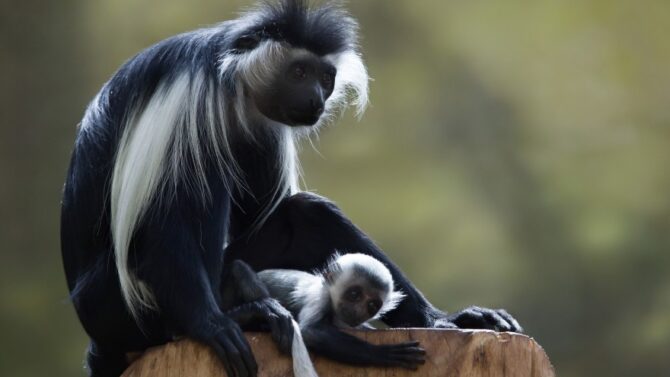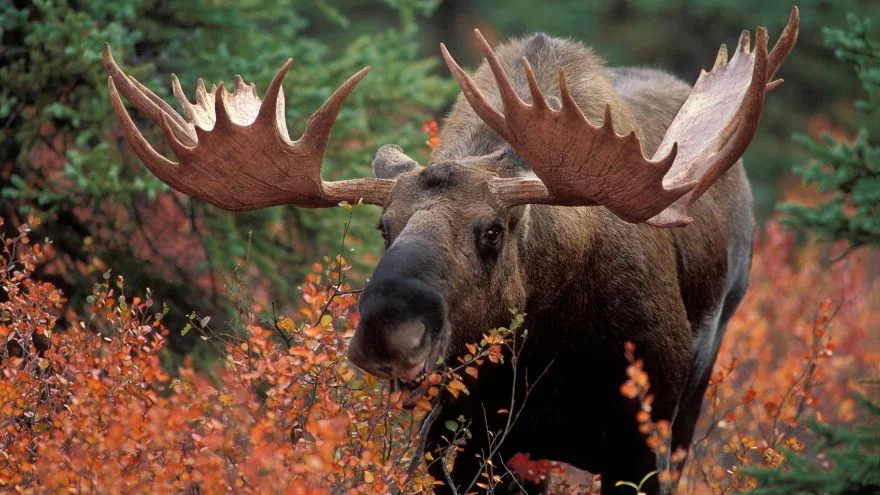Pennsylvania, also known as the Keystone State, is a North American state with luxurious hotels, sophisticated bars, and industrial importance in coal, steel, and railroads.
It’s also home to abundant wildlife, and while it has no native monkeys, there are still some monkey species in Pennsylvania.
Many Pennsylvanians will remember a recent incident where a pickup truck with an enclosed trailer full of 100 monkeys collided with a dump truck, with four monkeys escaping into Pennsylvania’s woods.1
While this incident remains a sore memory to recall, it confirms the presence of monkeys in Pennsylvania, the fifth-most populous state in the United States.
Currently, four non-native monkey species reside in several zoos in Pennsylvania: the white-faced saki, the François’ langur, the black-handed spider monkey, and the crab-eating macaque.
Read on to learn more about these animals, as well as their traits, lifespan, and range.
Why Is Pennsylvania a Good Habitat for Monkeys?
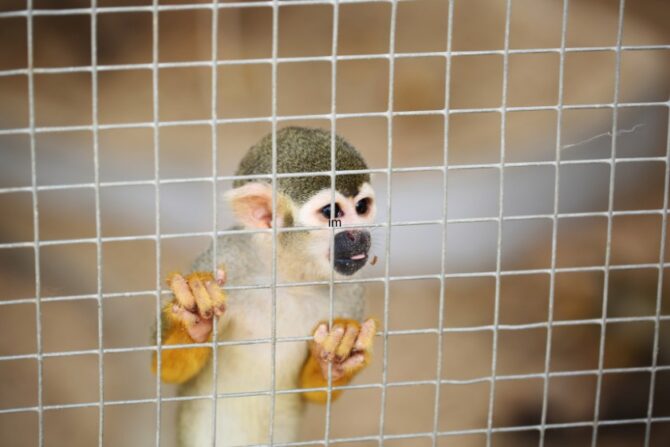
Pennsylvania has a humid continental climate characterized by long, warm, and moist summers, despite that it experiences wide shifts in seasonal temperatures.
This humid climate is similar to that of Asian and South American regions, where many monkey species are native to.
Although Pennsylvanian monkeys are mainly held in captivity, they are treated well in zoos, where they enjoy diets containing fruits, leaves, and seeds from the trees and vegetation within their enclosure.
Now that you know why Pennsylvania is a suitable habitat for monkeys, let’s look at the monkey species one might encounter in the state.
4 Monkey Species in Pennsylvania
1. White-Faced Saki
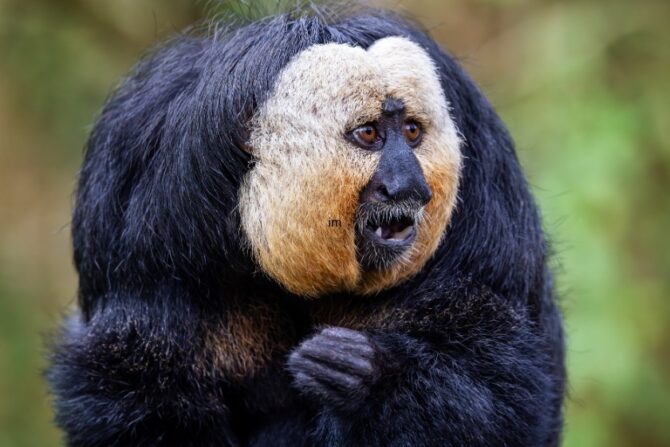
Scientific Name: Pithecia pithecia
Conservation Status: Least concern
Length: 12 to 16 inches
Weight: 4 to 5.2 lbs (males) and 3 to 4.1 lbs (females)
Lifespan: 14 years in their natural habitat and 36 years in captivity
Range: Northern South-American countries, including Brazil, Suriname, French Guiana, Venezuela, and Guyana.
The white-faced saki populates Brazil, French Guiana, Guyana, Suriname, and Venezuela in the wild, where fruits, nuts, seeds, and insects in the comfort of understory and lower forest canopies make their primary diet.
In Pennsylvania, however, these monkeys can be found in zoos like Philadelphia Zoo and Elmwood Park Zoo.
The white-faced saki is a sexually dimorphic species (male and female white-faced sakis look very different).2
However, this monkey is generally characterized by its brightly colored face, which may be gold or white, from which its name is derived.
Zoos enjoy the company of white-faced sakis for a long time, as this monkey can live up to 36 years in captivity despite spending around 14 years in their natural habitat.
Besides their lifespan, another interesting feature of these monkeys is that they are incredible leapers.
In fact, white-faced sakis travel by leaping approximately 70 percent of the time.
Of the remaining 30 percent, they spend 25 percent walking or running quadrupedally and less than 5 percent climbing.
2. François’ Langur
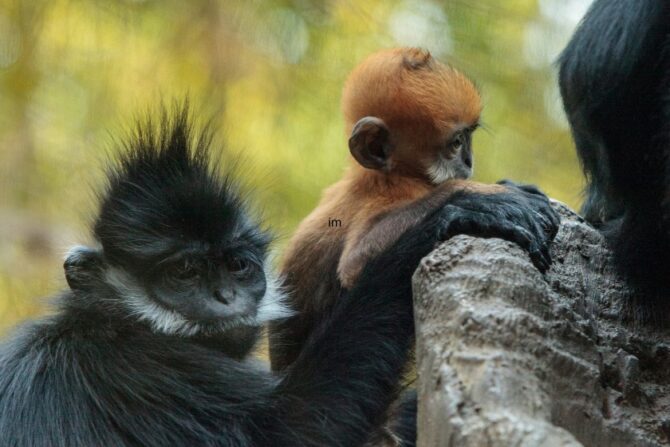
Scientific Name: Trachypithecus francoisi
Conservation Status: Endangered
Length: 2 feet
Weight: 14 to 17 lbs (males) and 12 to 17 lbs (females)
Lifespan: Up to 25 years
Range: Southwest China and Northern Vietnam
The François’ langur is among the least studied monkeys belonging to the Colobinae subfamily.
It is also listed as an endangered species3 and is estimated to have fewer than 2,150 individuals in its native range in Vietnam and China.
Remarkably, the Philadelphia Zoo in Pennsylvania is among the North American zoos housing 60 mature François’ langurs.
The François’ langur is easily recognizable due to its medium-sized body and black, silky hair with distinct white sideburns running from its ears to the corners of its cheeks.
These monkeys are social, living in groups of four to 27 individuals, although most groups usually consist of about 12 members.
In the wild, François’ langurs inhabit the cliffs and limestone caves in tropical and subtropical zones.
However, they are more adaptive to other habitats in the humid climate of Pennsylvania.
When kept in captivity, François’ langurs eat whatever their zookeepers provide them with.
Their diet typically includes young leaves, flowers, fruits, stems, seeds, barks, and also insects.
3. Black-Handed Spider Monkey (Geoffroy’s Spider Monkey)

Scientific Name: Ateles geoffroyi
Conservation Status: Endangered
Length: 12 to 25 inches (excluding tail)
Weight: 12 to 20 lbs
Lifespan: 22 to 25 years in the wild and up to 40 years
Range: Central and South America
Pennsylvanians don’t need to travel to Central American forests to enjoy the pleasure of seeing a black-handed spider monkey.
They can simply visit the Erie Zoo in Pennsylvania, where several of these monkeys are kept.
The black-handed spider monkey is a large-sized New World monkey with a physical appearance that varies by population and subspecies.
Its fur can be reddish, black, brown, buff, rust, or black, with black or darker shades on its hands and feet.
It also has bare skin or a pale mask around its eyes and muzzle.
One feature that sets black-handed spider monkeys apart is their strong, prehensile tails with palm-like pads at their ends.
They also have fascinating sexual organs, as the females’ clitorises are large and protruding—much larger than the males’ flaccid penises.4
4. Crab-Eating Macaque

Scientific Name: Macaca fascicularis
Conservation Status: Endangered
Length: 15 to 22 inches
Weight: 6 to 15 lbs
Lifespan: 15 to 30 years
Range: Southeast Asia
Crab-eating macaques are characterized by their dark brown or yellowish-brown upper bodies, light gray underparts, light golden brown tips, and dark gray or brown tails.
These monkeys are native to Southeast Asia and are popular among humans for their cultural significance.
While they have a bad reputation for being agricultural pests, they are also viewed as sacred animals and are, unfortunately, used for medical experiments.
In the wild, crab-eating macaques thrive in Southeast Asia’s lowland rainforests, shrubland, and coastal forests.
However, they can also be found in Pennsylvania, where scientists use them as subjects for medical experiments.
Human Interactions with Monkeys in Pennsylvania
Although wild monkeys usually avoid people, populations or individual monkeys may often venture closer to humans.
However, captive monkeys, like those in zoos, can become aggressive when fed by the general public.
These monkeys may display hostile behaviors when visitors refuse to feed them.
In January 2022, a truck transporting 100 monkeys to a quarantine facility was involved in an accident, leading to the escape of four monkeys into the woods in Pennsylvania.
Fortunately, all the monkeys were recaptured within a few days.5
This event is the most recent popular report of monkeys interacting with humans in Pennsylvania.
Frequently Asked Questions (FAQs)
Are There Other Primates in Pennsylvania?
Monkeys are not the only primates in Pennsylvania. Gibbons, another primate species, can also be found in the Philadelphia Zoo in Pennsylvania.
Where in Pennsylvania Can You Find Monkeys?
While the discovery of monkeys in Pennsylvania can be exciting, stumbling upon these animals in the wild without adequate preparation can be dangerous.
However, for those seeking to safely observe these creatures in Pennsylvania, the Erie Zoo, Elmwood Park Zoo, and Philadelphia Zoo are some great options to consider.
Wrapping Up
One can’t claim to have fully explored Pennsylvania’s wildlife without visiting its diverse monkey species.
From the crab-eating macaque to the black-handed spider monkey, François’ langur, and white-faced saki, there are several options to explore.
Therefore, if you reside in the Keystone State, make an effort to visit one of the three zoos mentioned above.
These zoos provide a safe environment for people to observe and appreciate these wild monkeys up close.
References & Notes
- Monkeys Escape After Truck Crashes on Pennsylvania Highway. The New York Times
- Pithecia pithecia. Animal Diversity Web
- François’ Langur. Endangered Primate Rescue Center
- Geoffroy’s Spider Monkey, Ateles geoffroyi. New England Primate Conservancy
- All 100 lab monkeys accounted for after several escape crash. Associated Press News

